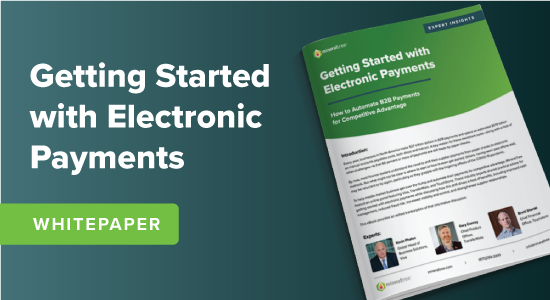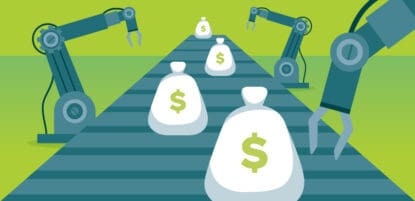Over the past few decades, we have seen constant advances in electronic payments and ePayment systems thanks to their unmatched convenience. As consumer adoption has skyrocketed, businesses have started to follow suit with the need for, and benefits of, electronic payments becoming even more pronounced.
Transitioning to electronic payments can help your organization pay vendors quickly, reduce risk, increase control, and improve visibility. There is a reason why thousands of middle-market businesses are leading the way to a paperless accounts payable future by taking advantage of e-payments.
Key takeaways
- By digitizing payments, businesses can simplify processes and minimize manual errors.
- There are various electronic payment types, each with its own pros and cons. It’s critical to choose the right option for your business’s unique needs.
- With MineralTree, electronic payments can be automated to help minimize error and keep processes running simply and smoothly with seamless integration.
What is an electronic payment, or ePayment?
Electronic payments, or e-payments, are a way of making transactions or paying bills online or through an electronic medium, without the use of physical checks or cash. The most popular methods of electronic payments include credit cards, debit cards, virtual cards, and ACH (direct deposit, direct debit, and electronic checks). For example, when a vendor performs a service for your business and sends the invoice electronically, the process of paying the vendor via credit card, debit card, etc. is considered an electronic payment. With most electronic payment methods, the hard costs and fees associated with traditional B2B payments like checks are no more — including paper, postage, and manual labor expenses.
The benefits of ePayments
Electronic payments and e-payments systems are highly beneficial to both businesses and their suppliers. In the context of accounts payable, e-payments are a win-win in that they reduce costs, improve relationships, increase visibility and provide enhanced security when compared to traditional checks. Here’s how:
Lowered processing costs
The more payments a business can process electronically, the less they spend on paper and postage, along with the time required to print, sign, stuff, and mail checks. In fact, shifting to a holistic ePayments strategy can reduce payment processing costs by up to 80%.
Strengthened supplier relationships
Businesses can improve vendor relations by facilitating quicker, more secure payments that include rich remittance data for easier reconciliation.
Increased payment security
Electronic payments are inherently more secure than paper checks, and specific methods like virtual cards offer even greater protection against fraud. On top of that, best-in-class ePayment systems include additional features and controls to help secure the payments process.
Enhanced visibility
ePayment systems provide your business with greater visibility into payment statuses, financial metrics, and accurate audit trails. They additionally reduce the costs and probability of data entry mistakes.
What are the different types of electronic payments
While there are many different types of electronic payments, below are the most common categories that make up the majority of e-payments.
- Card payments: Credit and debit card payments are the most common type of electronic payments. Despite their decreasing popularity among younger generations, credit card payments continue to be the most utilized electronic payment form due to their rewards and rebate offerings.
- Bank transfer payments: A bank transfer is when funds are moved from one bank to another and can be done in a few different ways. Most bank transfers are conducted via direct deposit, where payments are deposited electronically into the recipient’s bank account. However, in the U.S., bank transfers are conducted with ACH transfer payments.
- Virtual card payments: A virtual card is a randomly-generated 16-digit number that can only be used for the specified amount and charged once. Because of this, virtual cards ensure secure payments that are impossible to decrypt.
- Cross-border/FX payments: FX payments, also known as international payments, and cross-border payments allow businesses to send and receive money internationally. This process is conducted via wire transfers, forward contracts, cross-currency transactions, and more. It’s especially useful for businesses working with international customers and suppliers.
The pros and cons of different electronic payment types
It’s likely that your business will utilize a combination of electronic payment methods. In order to reap the most benefits, it is important to understand the risks and rewards of each option. Some methods are better suited to certain situations: For example, ACH debit pulls are best for recurring charges, whereas virtual cards are ideal for sending highly secure vendor payments.
Let’s explore the pros and cons of common electronic payment types:
ACH debit pull
These are most commonly used for payroll, such as direct deposit, and online payments. ACH debit pulls work via an electronic batch payment system wherein the payee or vendor initiates the “pull” of funds owed from the payer’s account.
- Pros: ACH debit pulls are typically low-cost, if not free.
- Cons: Pulls can take several business days to process and are high-risk compared to other e-payment options as vendors have access to your account information.
ACH credit push
These are most commonly used to make known vendor payments. ACH credit push also works via an electronic batch payment system but is differentiated by the payer initiating the payment and “pushing” funds outward from their account.
- Pros: ACH payments cost significantly less to process than credit cards and provide the flexibility of one-time or recurring payments
- Cons: Unlike debit pulls, banks charge a fee for ACH credit pushes, making them costly to process. In addition, ACH payments involve real account information, making them higher risk. They are typically only available to larger companies with high-volume payments. With both ACH debit pulls and ACH credit pushes, transaction data is not automatically transferred, leading to more time spent reconciling invoices.
Related content: With ACH Fraud on the Rise, Accounts Payable Teams Need to Be Vigilant
Credit card
Credit cards are most commonly used to make retail purchases. They allow the cardholder to borrow money from the card issuer up to a predefined limit.
- Pros: These are merchant-initiated transactions paid from the cardholder’s credit line, making them a speedy, personal payment method.
- Cons: Vendors may not accept credit cards due to associated processing fees. In addition, a plastic card with a single number to make all payments is susceptible to fraud.
Debit card
Like credit cards, debit cards are most frequently used to make retail purchases and are merchant-initiated transactions. However, instead of charging funds to the cardholder’s credit line, these transactions are pulled directly from the cardholder’s bank account.
- Pros: With debit card payments, the vendor is provided certainty of payment as well as the benefits of saved time and effort.
- Cons: While just as low-cost and convenient as credit cards, debit cards offer little protection for purchasers and are only slightly less expensive for vendors to accept.
Commercial card
Commercial cards are credit cards issued by organizations to employees to pay for business-related purchases directly from a corporate line of credit. These transactions are typically T&E expenses, recurring payments, and vendor purchases.
- Pros: Commercial cards are low-cost, speedy, and fairly secure.
- Cons: However, they are often difficult to track and reconcile from an invoice perspective.
Virtual card
A virtual card is a plastic-less card that allows businesses to generate single-use 16-digit numbers that are authorized for a specific payment amount.
- Pros: Virtual cards have zero cost to the payer, are speedy, and highly secure due to a process called payment tokenization that ensures the business’s bank account information cannot be compromised. They also allow businesses the opportunity to receive rebates on purchases.
- Cons: Currently, a smaller percentage of vendors accept virtual cards compared to other methods, though this number is growing as both businesses and suppliers better understand the benefits.
Purchasing card (P-Card)
Like commercial cards, P-cards are a type of company credit card that allows purchases to be made without using traditional invoice creation. The difference is that P-cards typically have additional restrictions or spending limits when it comes to corporate purchases.
- Pros: They’re also low-cost, fairly secure, and speedy.
- Cons: There’s an inherent difficulty in auditing individual P-card transactions for high-risk or fraudulent activity.
Wire transfer
Wire transfers are real-time payments that can be made for domestic and international purchases. Cash is automatically transferred from one account to another.
- Pros: Initiation of a wire transfer can take only minutes and, within the U.S., transfers can be processed as quickly as same-day. Because wire transfers require a confirmation of funds, they are a more guaranteed payment method than paper checks.
- Cons: Unfortunately, wire transfers are costly and pose a significant security risk to the payer, despite the quick turnaround time. Because of the immediate availability of transferred funds, wire transfers are prime targets for those who would look to hijack bank account information.
Because every business and vendor is different, it is highly unlikely that any organization will use only one electronic payment method in its accounts payable. As an organization grows and its processes become more complex, it becomes increasingly important that the business not only embrace electronic payments but employ integrated payables as a solution.
Did you know? MineralTree allows organizations to optimize their payment processes and choose the most efficient payment methods for a given transaction and improving working capital, ultimately providing you and your business with greater control over your payments.
Why your business needs to consider ePayments
If your business is still writing, signing, and approving paper checks, then you’ll continue to sacrifice precious time for processes that can easily be improved. Here are just a few reasons why your business should consider transitioning to e-payments.
Cost savings
The costs of processing and paying invoices are constantly underestimated. While the direct costs, such as paper, ink, and postage that go into check payments can run as high as $5 per check, ACH transfers cost a fraction of that.
Not only do electronic payments reduce costs for businesses, electronic credit card payments actually earn rebates. For example, a business that pays $10 million in vendor payments on their credit card could earn a 2% rebate, generating $200,000 in returns. Finance teams can strategically re-invest this cashback into their business to run more effectively and efficiently.
Convenience of ePayments
For businesses that pay electronically, the days of printing checks, chasing people down for signatures, stuffing checks into envelopes, and mailing checks out are gone. Paying electronically is a much simpler and more efficient process than dealing with paper checks. Several methods for paying electronically simplify the payment process, with the two primary methods being ACH transfers and virtual cards.
An ACH transfer moves money electronically from one bank to another. There are regular ACH transfers, which are cost-free and are processed within a few business days, and same-day ACH transfers which typically cost a small fee but allow for payments to be processed within the same business day.
The aforementioned virtual cards are another tool for making payments electronically. Paying vendors with virtual credit cards is an instantaneous process that requires zero hassle and zero paperwork.
These simplified payment processes lead to quicker payments and the opportunity to capitalize on early-pay discounts if offered by vendors.
Improved security
Electronic Payments are encrypted to protect critical data. For virtual card payments, a process called tokenization adds an extra level of security to ensure that sensitive credit card information is protected. During payment tokenization, an individual’s primary account number (PAN) is replaced with a randomly generated 16-digit number called a token. A vendor can only charge each token once for one specific amount. This ensures that credit card details are never exposed, mitigating the risk of fraud.
What is an ePayment system?
An ePayment solution is a tool that allows companies to make digital payments. The right tool allows organizations to pay vendors in their preferred format, whether that be ACH or virtual card, without additional workflows for the accounts payable team. MineralTree not only allows companies to easily make digital payments, but teams can also easily include check payments into the same workflow.
How automation enables electronic payments
According to the State of AP report, most organizations have plans to invest more in automation for enhanced efficiency. Seventy percent of buyers intend to convert more AP spend to digital payments, and 79% of vendors want to receive more digital payments. This is because roughly 76% of vendors feel that customers who pay electronically are more likely to pay on time. Automation allows teams to do more with less so they can process invoices and pay vendors quickly, helping to streamline processes for both buyers and vendors.
MineralTree is a leading AP Automation solution that streamlines the end-to-end AP process, making it easy to enroll vendors in electronic payments. Teams that have implemented MineralTree have seen a full return on their investment within 60 days of implementation and added time savings.
Interested in learning more? Schedule a demo to see how AP automation can help your team leverage electronic payments.
Electronic payments FAQs
What are common electronic payment methods?
The most common electronic payment methods include ACH, debit and credit cards, wire and bank transfers, digital wallets, and mobile pay.
How do electronic payments work?
Electronic payments can be categorized into two types: one-time vendor payments and recurring vendor payments. Both types are traditionally performed in the following three steps.
- Payment Initiation: The consumer chooses the type of electronic payment method.
- Payment Authentication: Information is submitted by the consumer, including any account numbers or security codes, and is then authenticated by the controller.
- Payment Settlement: Once the payment has been authenticated, the payment is made and successfully transferred to the merchant’s account via the electronic payment provider.
What is considered an electronic or online payment?
Any payments made digitially are considered an electronic payments. This includes ACH, virtual card, and credit card.
How do I make an electronic payment?
Electronic payments can be made any time your business pays for a service. With MineralTree TotalAP, electronic payments are made automatically using your vendor’s preferred electronic payment method. You still get to determine which suppliers get paid when, but MineralTree will ensure timely payments are made using the most suitable payment method for your business.
What is the best electronic payment method?
The best electronic payment method depends on the type of service your business is paying for. However, for improved security, simplicity, and optimized cash flow, virtual card payments enable businesses to do all this while creating a revenue stream simply by paying your vendors.
What are the benefits of electronic payments for businesses?
By shifting to electronic payments, businesses will experience improved payment security, greater simplicity, strengthened supplier relationships, lower processing costs, enhanced visibility, and more. Learn more about the benefits of electronic payments for your business.
Can electronic payments be automated?
Electronic payments can be automated with the help of integrated payment platforms, systems like ACH and credit card processors. Automating electronic payments can reduce human error and streamline efficiency.
What are the challenges of implementing electronic payments for a business?
Implementing electronic payments can be challenging, as it involves complex integrations, high processing costs, staff training and awareness, and compliance and security concerns.
What are the safest digital payment methods?
There are several digital payment methods that are considered safe and secure options. A few payment methods that are considered to be the safest include virtual card payments and ACH payments. According to the most recent AFP fraud survey data, virtual cards are one of the payment methods least vulnerable to fraud.
How long does electronic payment processing take?
The time it takes for electronic payments to process can vary depending on the application and the specific e-payment method. That said, the processing time for most electronic payment methods is 1-3 days; 3-5 days for bank transfers, 1-3 for credit card payments, and 1 day for virtual card payments.
What are the risks in ePayments?
All payments are subject to risk, including fraud. However, checks are more susceptible to fraud than other payment methods, with 65% of respondents in the AFP® Payments Fraud and Control Survey Report noting that their companies had faced check fraud attacks. Additionally, AP automation tools can help protect businesses from bad actors by automatically cross-checking vendor information.
What is the best way to pay bills electronically?
The best way for companies to pay bills online is through an AP automation tool. These tools allow organizations to pay vendors in their preferred formats without adding additional work to the finance team. Additionally, all information can sync back to the ERP, so that the ERP remains the system of record.




